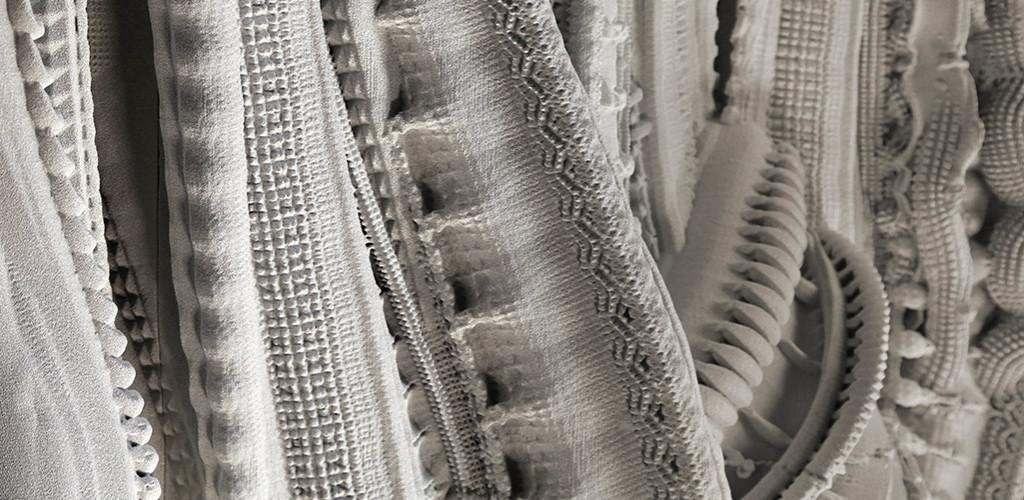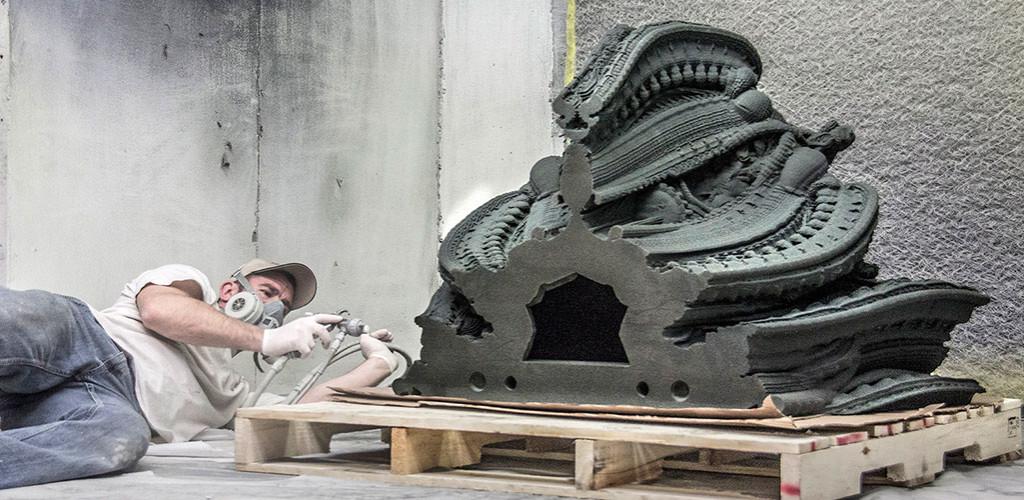 This past summer, from mid-May to late-August, an important 3D printing exhibition in Toronto, Canada titled “3DXL” was the venue for some of the most extraordinary, large-scale, 3D printed architectural works. Presented by Design Exchange (DX), the ultra-chic, cutting-edge Canadian Design Museum and curated by Sara Nickelson of DX, the exhibition was actually held off-site in what DX referred to on its site as a 3,500-square-foot “glass box.” Passersby on the busy Toronto corner where the show was held were dazzled by numerous 3D printed objects by avant-garde designers from across the globe that we imagine can only presage the bright, creative future of 3D printed architecture.
This past summer, from mid-May to late-August, an important 3D printing exhibition in Toronto, Canada titled “3DXL” was the venue for some of the most extraordinary, large-scale, 3D printed architectural works. Presented by Design Exchange (DX), the ultra-chic, cutting-edge Canadian Design Museum and curated by Sara Nickelson of DX, the exhibition was actually held off-site in what DX referred to on its site as a 3,500-square-foot “glass box.” Passersby on the busy Toronto corner where the show was held were dazzled by numerous 3D printed objects by avant-garde designers from across the globe that we imagine can only presage the bright, creative future of 3D printed architecture.
 The show’s pièce de résistance was surely the work titled Arabesque Wall, by architects and designers, Benjamin Dillenburger and Michael Hansmeyer. Hansmeyer works in the field of Computational Architecture. He uses, as he explains on his website, “algorithms and computation to generate architectural form.” At the moment, he is employed as a visiting professor at Southeast University in Nanjing, Jiangsu Province, China. He holds a Master of Architecture degree from New York City’s Columbia University as well as an MBA degree from INSEAD Fontainebleau.
The show’s pièce de résistance was surely the work titled Arabesque Wall, by architects and designers, Benjamin Dillenburger and Michael Hansmeyer. Hansmeyer works in the field of Computational Architecture. He uses, as he explains on his website, “algorithms and computation to generate architectural form.” At the moment, he is employed as a visiting professor at Southeast University in Nanjing, Jiangsu Province, China. He holds a Master of Architecture degree from New York City’s Columbia University as well as an MBA degree from INSEAD Fontainebleau.
Dillenburger is an architect and, at the moment, an assistant professor of Architecture at the John H. Daniels Faculty of Architecture, Landscape and Design at the University of Toronto. He has also worked as a senior lecturer in the CAAD group at Swiss Federal Institute of Technology’s architecture department in Zurich. Dillenburger was a finalist in the MoMA PS1 Young Architects Program 2015.
The two form a formidable design team as their collaborative work Arabesque Wall demonstrates. The work, which took four months to design, is massive, standing around 10’ high. It is comprised of 12 components that were 3D printed in sandstone. The piece weighs 0.8 tons, yet was printed in only four days and was assembled in just four hours, which seems astonishing given the complexity of the work.
With roughly 200 million surfaces, Arabesque Wall resembles an elegant, symmetrical tangle of Baroque-period decorative flourishes. The solidity of the piece, however, confers a sobriety that is quite contrary to the sense of excess the Baroque style typically communicates. It’s as though an ancient megalith suddenly bloomed Baroque. Possibly, the element of extravagant visual license is in the details: according to its creators, the Arabesque Wall is the first architectural work designed with a resolution measured in micrometers (that is, one millionth of a meter).
Dillenburger described the 3D printing process to reporter Sandy Wang at “The Varsity,” the University of Toronto’s student newspaper, “the sandstone elements are fully enclosed by loose sand when they are coming out of the printer. One of the nicest moments of this project,” he recalled, “was the excavation of those elements, which feels like an archaeology of your own design.”
Both Dillenburger and Hansmeyer seem confident in an almost prescient way that their work is paving the way for an architecture of the very near future that features 3D printing in a crucial, central role.
In that regard, Hansmeyer wrote of Arabesque Wall:
“In uniquely employing 3D printing for its fabrication, the Arabesque Wall heralds a highly differentiated and spatially complex architecture in which ornament and formal expression cease to be a luxury. Using computational design and digital fabrication, even the most lavish and one-of-a-kind architecture can now be materialized with relative ease.”
Dillenburger hopes to see “new digital building technologies also applied to larger projects,” in which case somewhat fragmentary works like Arabesque Wall–arguably more sculpture than architecture–would comprise a piece of the large whole. He envisions a 3D printed house created via bold experimentation, digital design and fabrication. Moreover–and in the spirit of experimentation–both architects believe it’s time to stop “imitating existing designs” and instead “explore the new freedom” that digital technologies and 3D printing provide. Perhaps, in a way, the glorious jumble of what seem like cast-off ornaments of a distant architectural past makes Arabesque Wall both a tribute and a fond farewell to anachronistic approaches.
What are your thoughts on this wall? Discuss in the 3D Printed Arabesque Wall forum thread on 3DPB.com.
Subscribe to Our Email Newsletter
Stay up-to-date on all the latest news from the 3D printing industry and receive information and offers from third party vendors.
You May Also Like
NSF Awards Kentucky $1M for Advanced Manufacturing
The National Science Foundation has awarded a $1 million grant to the University of Louisville for the Advancing Manufacturing and Building Construction Technologies (NSF AMT) project. This initiative is part...
3D Printing News Briefs, May 11, 2024: 3D Printed Stent, Tower, Sculptures, & More
We’re starting off with medical research in today’s 3D Printing News Briefs, as researchers in Korea used CT images and 3D printing to fabricate an educational simulator for a mastoidectomy....
3D Printing Unpeeled: Wind Turbines, Probiotics and Lenses
TPI Composites, ORNL and Ingersoll Rand are working to make wind turbine tooling segments that can be 18.3 meters long. These elements also include resistive wires that help keep the...
Tethon 3D Releases Cost-effective Bioprinter
Tethon 3D, known for its ceramic-loaded DLP materials, custom resins, and DLP 3D printers, has recently released a bioprinter. Vat polymerization printers like DLP systems have been widely used by...

































